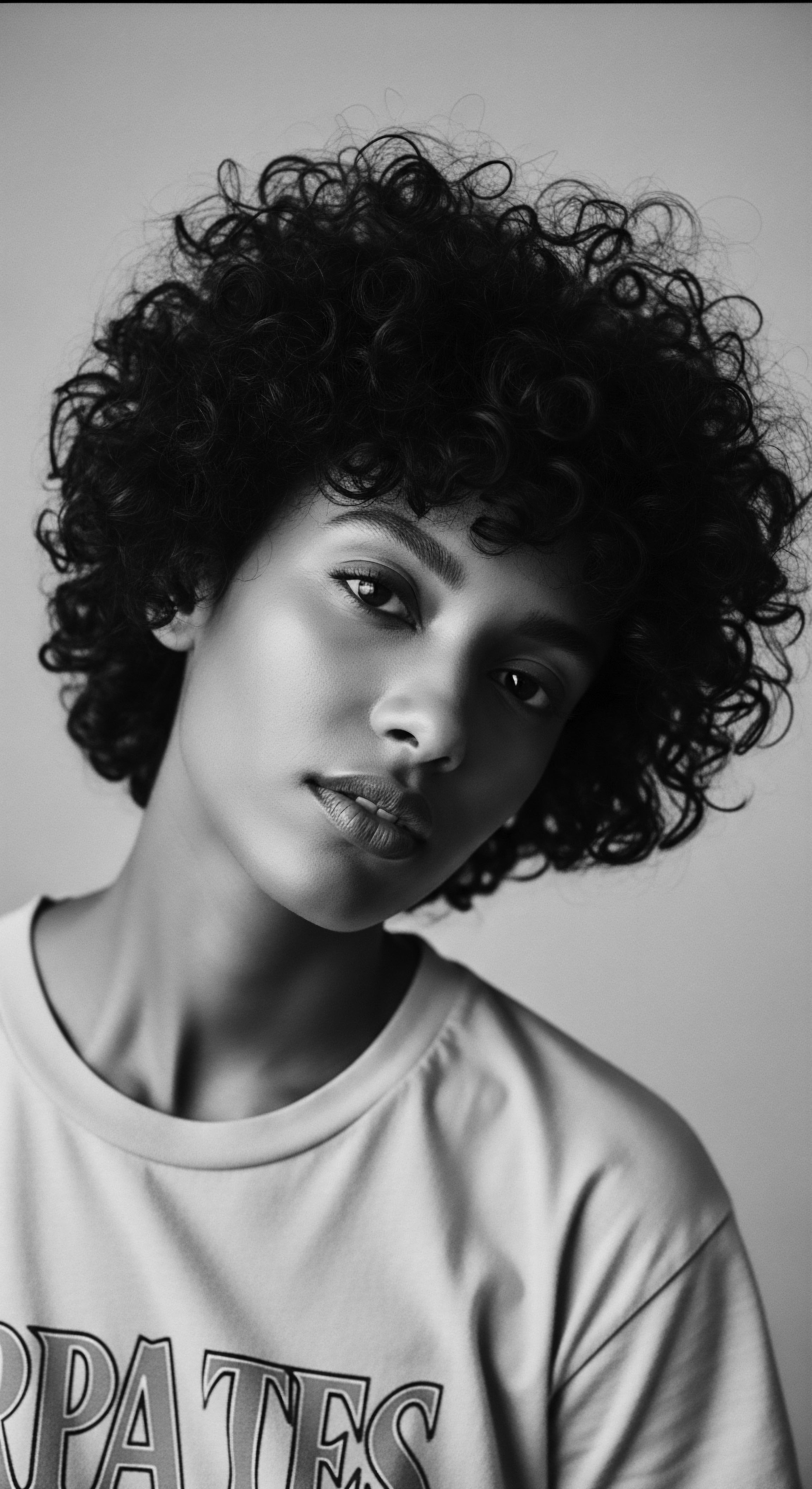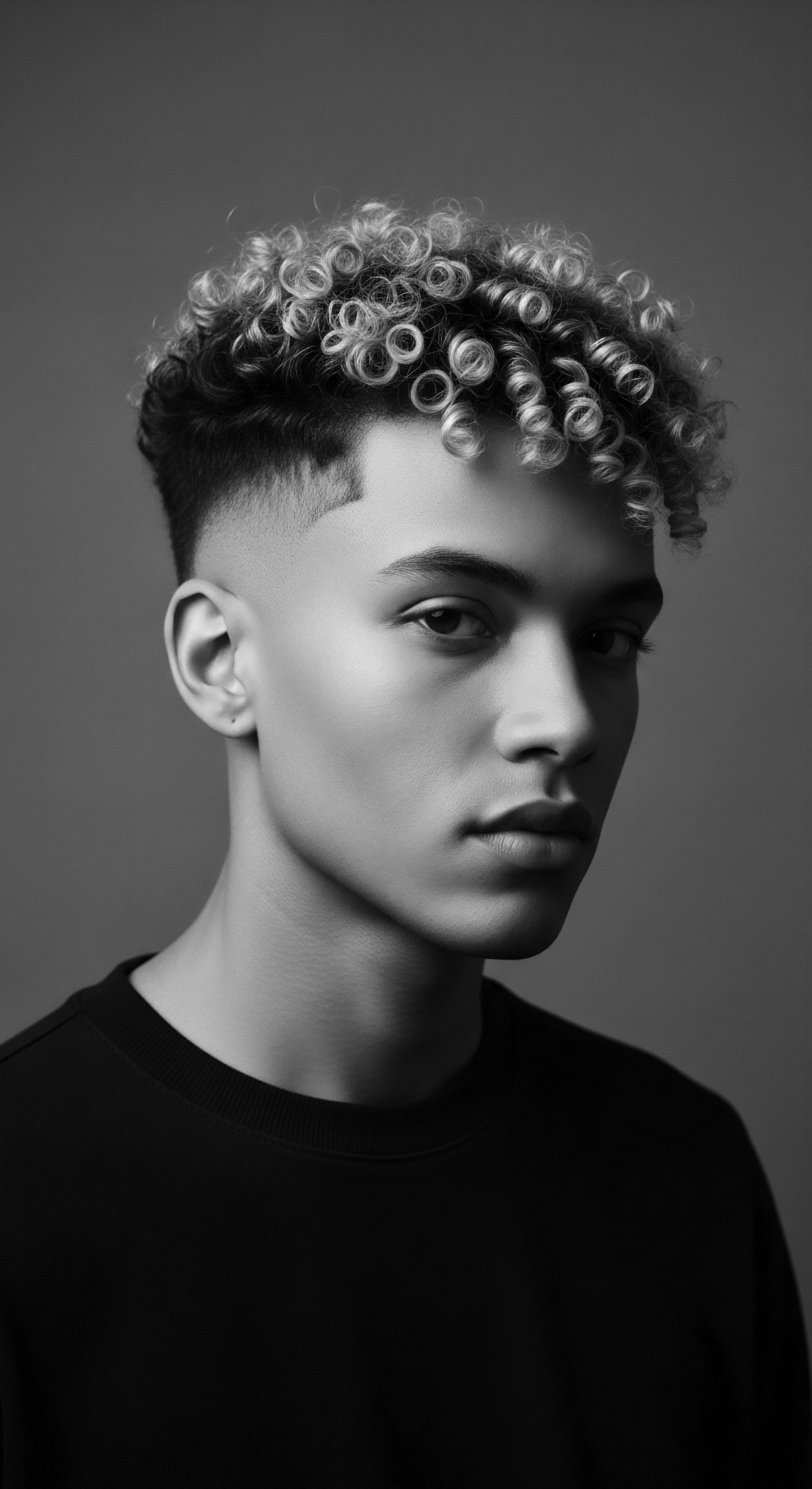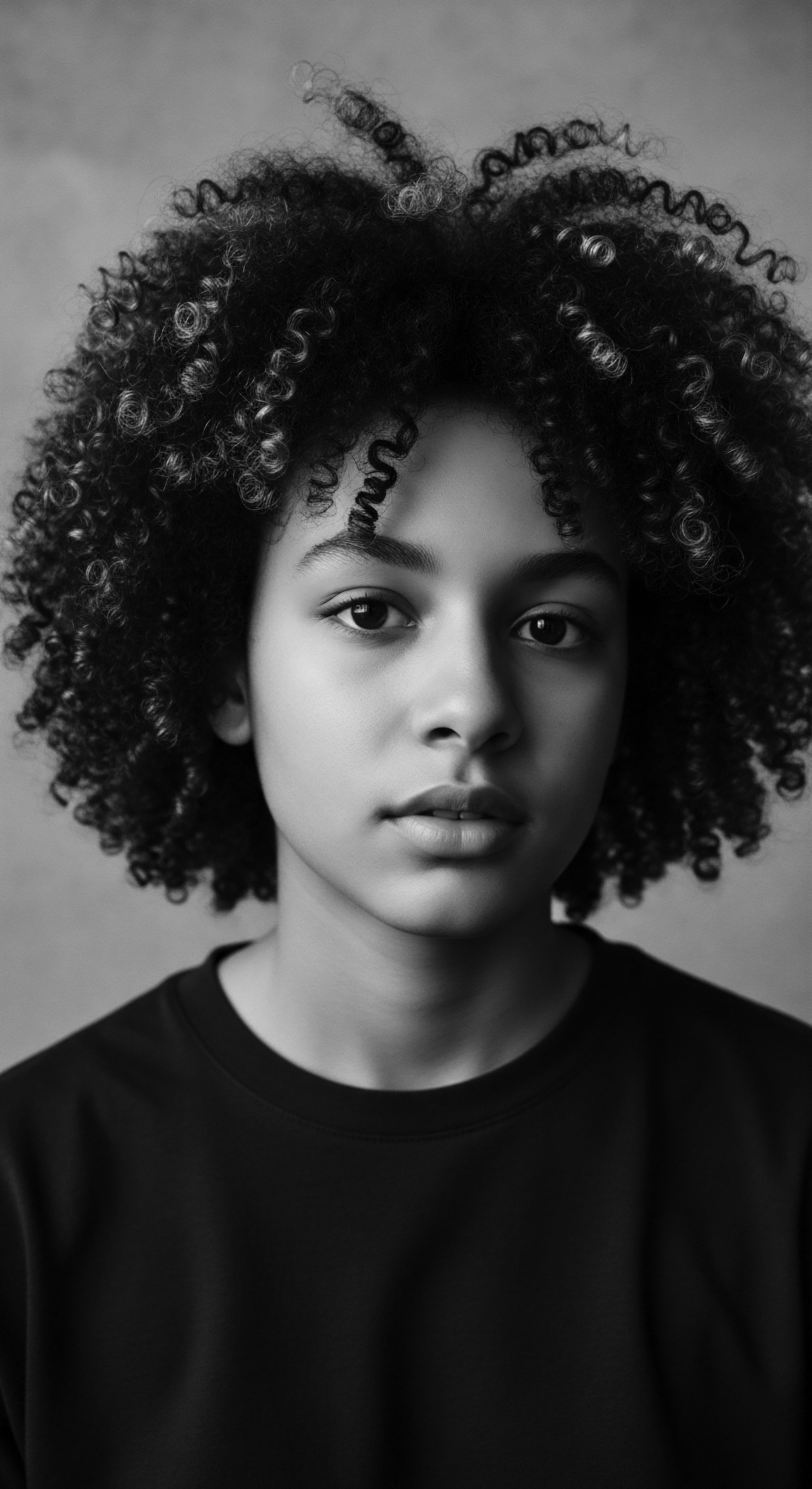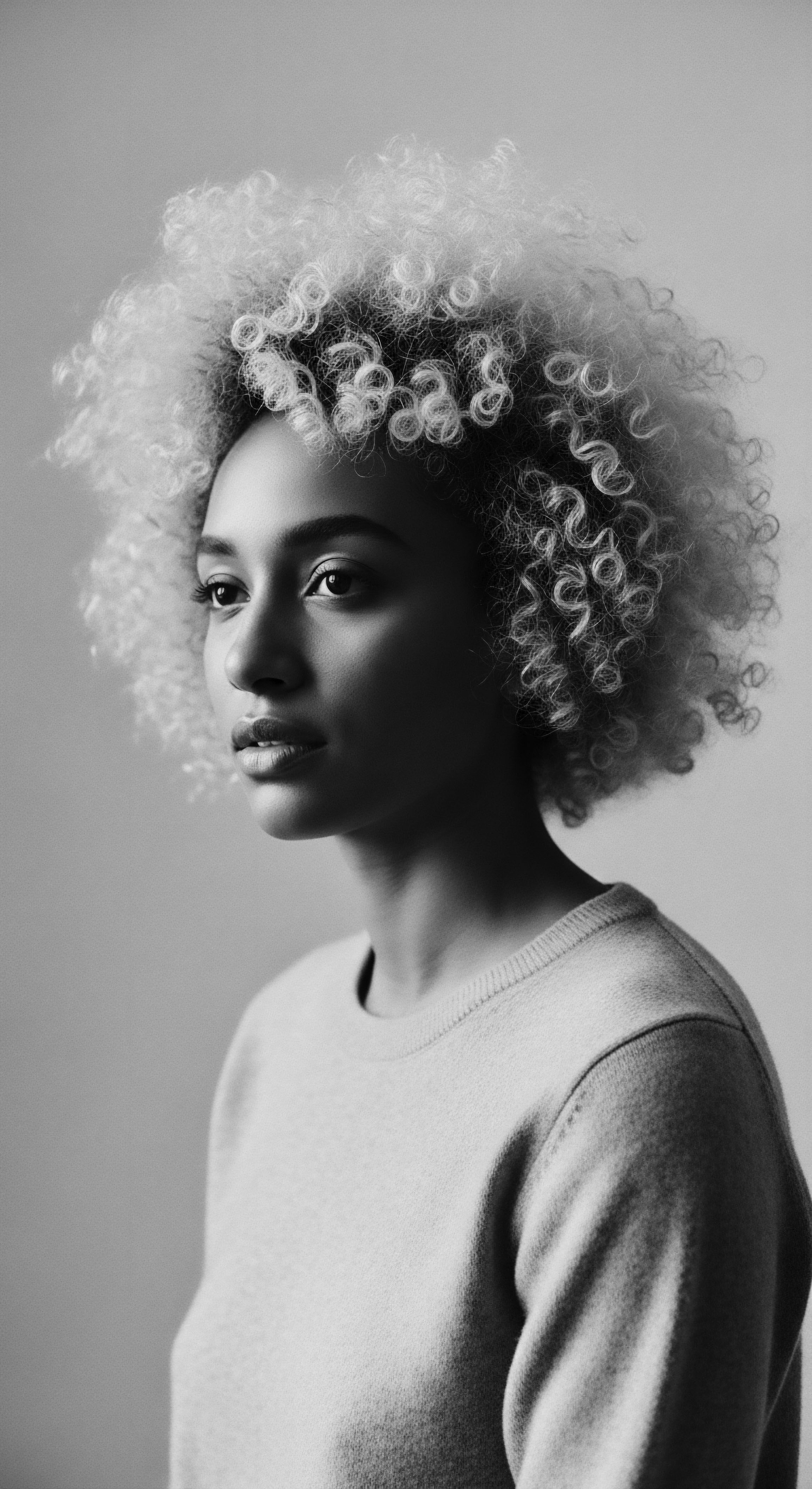
Fundamentals
The conversation surrounding hair has, for generations, been far more than a discourse on mere aesthetics or superficial adornment. It has always been a profound narrative woven into the very fabric of identity, a declaration of lineage, and a testament to resilience, particularly for individuals of Black and mixed-race heritage. Within this rich legacy, understanding the fundamental building blocks of our strands holds a unique power. At its very core, hair—every strand, whether tightly coiled, loosely waved, or straight—is composed predominantly of a protein known as keratin.
For textured hair, the significance of keratin acquires additional layers of meaning. Here, the Definition of keratin transcends its chemical composition, extending into a realm of cultural understanding. It refers to the fibrous structural protein that forms the primary component of hair, nails, and the outer layer of skin.
In the context of textured hair, this protein, with its complex array of amino acids and intricate disulfide bonds, dictates the hair’s unique curl pattern, its strength, and its intrinsic needs. The way these keratin proteins are arranged and bonded within the hair shaft gives textured hair its characteristic shape, elasticity, and often, its remarkable volume and ability to hold diverse styles.
An initial Explanation of textured hair keratin reveals it as the scaffolding upon which our hair’s distinct architecture is built. This unique architecture is not a random occurrence; it is a hereditary marvel, a biological inheritance that speaks volumes about ancestral pathways and climatic adaptations. The very curl and coil of textured hair are a direct expression of how keratin proteins align and bond along the hair shaft. This alignment is influenced by the hair follicle’s shape—an elliptical or flattened follicle produces curled hair, while a round follicle yields straight hair.
Textured hair keratin, a fibrous protein, forms the foundational architecture dictating curl patterns, strength, and the unique needs of ancestral hair.

The Intrinsic Nature of Textured Hair Keratin
When considering textured hair, the internal structure of the keratin itself plays a commanding role. Unlike the more uniform cylindrical structure found in straight hair, textured hair often exhibits an elliptical or even flattened cross-section. This shape influences how the keratin fibrils—bundles of protein—are organized within the hair cortex.
The bonds that connect these keratin fibrils, particularly the disulfide bonds, are distributed in a way that contributes to the hair’s coiled shape. This means that a single strand of textured hair may experience varying degrees of tension and compression along its twists and turns, making certain areas potentially more vulnerable to environmental stressors or mechanical manipulation.
The Description of this internal arrangement offers a fresh perspective on ancestral care. For generations, communities meticulously cultivated haircare rituals without the benefit of modern microscopes or biochemical analyses. Their wisdom, passed through oral tradition and practiced demonstration, intuitively addressed the very challenges posed by textured hair keratin’s unique structure.
They understood the hair’s delicate nature, its thirst for moisture, and its need for careful handling. This collective knowledge formed an ancestral science, a practical trichology born of observation and deep connection to the living world.
- Hair’s Inner Structure ❉ The way keratin proteins are arranged and bonded within the hair shaft gives textured hair its characteristic shape and elasticity.
- Follicle’s Influence ❉ The elliptical or flattened shape of the hair follicle directly dictates the curl pattern and the resulting keratin distribution.
- Strength and Delicacy ❉ Textured hair’s helical structure, while robust, also creates points of mechanical stress where keratin bonds are particularly vulnerable.

Intermediate
Moving beyond the foundational understanding, the intermediate Meaning of textured hair keratin invites a deeper appreciation of its biomechanical properties and how they have been intuitively managed through centuries of ancestral care. The intricate coiling and curling of textured hair are not simply aesthetic features; they are expressions of a complex interplay between the keratin macrofibrils, the cell membrane complex that binds them, and the very hydrogen and disulfide bonds that provide structural integrity. The hair’s natural inclination to coil creates distinct points of curvature, where the hair shaft experiences varying degrees of stress and strain.
This inherent structural reality means that textured hair, while possessing remarkable resilience along its length, can be more susceptible to breakage at these sharp bends, particularly when exposed to dryness or harsh manipulation. The Interpretation of this biomechanical reality allows us to see the brilliance of traditional hair care practices, which were, in essence, early forms of keratin management. Ancestors did not have the scientific nomenclature, but they possessed a profound observational understanding of their hair’s behavior, its breaking points, and its needs for moisture and gentle handling.
Ancestral hair care practices represent an implicit understanding of textured hair keratin’s biomechanical properties, safeguarding its unique structural integrity.

Ancestral Chemistry ❉ Care Rituals and Keratin Preservation
Consider the historical and cultural significance of practices such as communal oiling rituals, the application of natural butters, or the meticulous process of braiding and twisting hair. These were not random acts; they were sophisticated methodologies for preserving the hair’s intrinsic protein structure. The emollient properties of shea butter or the lubricating qualities of palm oil, for instance, did not just moisturize; they also created a protective barrier around the cuticle, the outermost layer of the hair, which safeguards the keratin within. By sealing the cuticle, these traditional applications helped prevent moisture loss, thereby maintaining the hair’s pliability and reducing the likelihood of mechanical damage that could compromise the keratin bonds.
The practice of protective styling, deeply ingrained in various ancestral traditions, serves as a powerful testament to this intuitive understanding. Braids, cornrows, and twists, often adorned with beads or cowrie shells, extended beyond mere aesthetic expression. They minimized daily manipulation, shielded hair from environmental aggressors like sun and dust, and reduced friction against clothing, all factors that contribute to cuticle damage and subsequent keratin degradation.
This deliberate shielding allowed the hair to retain its natural oils and moisture, thus supporting the integrity of the keratin network. The Delineation of these practices shows how deeply intertwined ancestral wisdom was with the physical realities of textured hair.
| Ancestral Practice Oiling Rituals (e.g. Shea Butter, Palm Oil) |
| Implicit Benefit to Keratin Forms a protective barrier, seals cuticle, maintains moisture, reduces breakage at stress points. |
| Ancestral Practice Protective Styling (e.g. Braids, Twists) |
| Implicit Benefit to Keratin Minimizes manipulation, shields from environment, reduces friction, preserves natural oil balance. |
| Ancestral Practice Gentle Detangling (e.g. Finger Detangling) |
| Implicit Benefit to Keratin Prevents mechanical stress on keratin bonds, preserves integrity of the hair shaft at its vulnerable curves. |
| Ancestral Practice These long-standing methods subtly addressed the unique structural needs of textured hair's keratin, promoting its strength and longevity across generations. |

The Legacy of Manipulation ❉ Braids, Twists, and Tension
The hands that braided hair centuries ago were, in their own way, engaging in a dialogue with the hair’s keratin structure. Each twist and plait was a conscious act of shaping and securing, not just for appearance, but for sustenance of the strand. This purposeful handling reduced the frequency of combing and brushing, which, particularly on dry textured hair, can cause significant friction and breakage, ultimately weakening the keratin matrix. The historical narrative of hair styling in Black and mixed-race communities is a living archive of intelligent adaptation.
The Elucidation of these techniques reveals a profound ancestral knowledge base. Women, men, and children gathered, often in communal settings, for the intricate processes of hair preparation and styling. These moments were not just about personal grooming; they were social occasions, passing down wisdom, stories, and methods from elder to youth.
The careful sectioning of hair, the precise tension applied during braiding, and the subsequent moisturizing of the scalp and strands all worked in concert to support the hair’s keratin, allowing it to flourish under conditions that might otherwise cause significant damage. The communal aspect reinforced the importance of sustained care, which directly contributed to the long-term health and integrity of textured hair’s protein structure.
- Gentle Handling ❉ Ancestral practices emphasized minimal manipulation to preserve the delicate keratin bonds and cuticle layers.
- Communal Wisdom ❉ Hair care often occurred in shared spaces, where practical knowledge about maintaining textured hair was exchanged and reinforced.
- Purposeful Styling ❉ Braids and twists were chosen not only for beauty but also as effective strategies for reducing daily wear and tear on the keratin structure.

Academic
The academic Definition of Textured Hair Keratin transcends rudimentary descriptions, demanding a rigorous examination of its intricate biophysical properties and socio-historical implications. It represents a specialized form of alpha-keratin, exhibiting unique morphological and mechanical characteristics directly influencing the macroscopic appearance and intrinsic behavior of coiled, kinky, and curly hair strands. The Specification of this protein in textured hair involves a nuanced understanding of its crystalline and amorphous regions, the differential distribution of cysteine residues leading to a higher concentration of disulfide bonds at specific points of curvature, and the inherent stresses introduced by the elliptical or flattened cross-sectional geometry of the hair fiber itself.
This structural particularity renders textured hair simultaneously robust in its tensile strength along the fiber axis yet inherently susceptible to mechanical fragility at the apexes of its numerous bends. The cortical cells within textured hair often demonstrate a differential growth rate or orientation, leading to the formation of a bilaterally asymmetric structure. This asymmetry contributes to the hair’s helical configuration, but it also creates regions where the keratin macrofibrils are under greater strain, predisposing the hair to breakage, particularly when dehydrated. The interplay between these microscopic realities and the macroscopic expression of hair health forms the bedrock of an academic understanding of textured hair keratin.
Academic inquiry into textured hair keratin reveals a biophysically complex protein whose unique structural arrangement, while creating characteristic curl, also presents specific mechanical vulnerabilities rooted in its helical geometry.

The Hereditary Helix ❉ Genetic Influences on Keratin Formation
The variations observed in textured hair keratin are not merely environmental adaptations but are deeply rooted in genetic predispositions. Specific genes, such as those within the TRICHOCYTE gene cluster, influence the shape of the hair follicle and, consequently, the manner in which keratinocytes differentiate and organize to form the hair shaft. This genetic blueprint dictates the elliptical nature of the follicle, which in turn orchestrates the asymmetric distribution of keratin and cortical cells, giving rise to the characteristic coiling pattern. The Explication of these genetic underpinnings underscores that textured hair’s keratin profile is an ancestral inheritance, a legacy carried within the very cellular machinery passed down through generations.
For instance, research has begun to pinpoint single nucleotide polymorphisms (SNPs) associated with variations in hair texture across populations, highlighting the polygenic nature of this trait. These genetic markers subtly influence the aggregation and cross-linking of keratin proteins, contributing to the distinct mechanical properties—elasticity, tensile strength, and propensity for breakage—observed in different textured hair types. This academic lens allows us to appreciate the biological profundity of hair, recognizing it as a living archive of human migration, adaptation, and genetic diversity. The understanding that the predisposition for unique keratin structure is inherited provides a scientific validation for the deep sense of belonging and identity many find in their textured hair.

Keratin and Cultural Resilience ❉ An Academic Inquiry
The historical context of textured hair keratin is inextricably linked to the socio-cultural landscape of Black and mixed-race experiences. Hair, as a visible marker, became a site of both oppression and resistance. During the transatlantic slave trade and subsequent periods of enslavement, indigenous African hair care practices were often disrupted, replaced by conditions that severely compromised the integrity of textured hair keratin.
The forced imposition of Eurocentric beauty standards often encouraged practices, such as chemical straightening, that fundamentally altered the hair’s natural protein bonds, leading to significant damage and hair loss. Yet, within these challenging circumstances, communities consistently found ways to preserve and honor their hair.
An academic examination reveals that traditional protective styles, often maintained with rudimentary tools and natural emollients, served not only practical purposes but also acted as acts of cultural preservation and quiet rebellion. These practices implicitly recognized the structural vulnerabilities of textured hair keratin and developed strategies to mitigate them, long before modern scientific understanding. For example, in many West African societies, the elaborate braiding of hair was a communal act, a time for intergenerational knowledge transfer regarding styling techniques and herbal preparations. These preparations, often derived from local plants, possessed properties that would, in modern terms, be understood as strengthening the hair fiber or promoting scalp health, thereby supporting optimal keratin production and integrity.
Consider the profound communal significance and practical efficacy of Traditional Hair Oiling Rituals among certain West African ethnic groups. A study by Agbanrin and Omoruyi (2018) examining traditional Nigerian hair care practices, while not directly focusing on keratin at a molecular level, documents the widespread use of plant-based oils and butters such as shea butter and palm kernel oil. These were applied regularly to hair and scalp, serving to lubricate the strands, minimize friction during manipulation, and protect against environmental damage. This practice directly correlates with the preservation of textured hair keratin by maintaining optimal moisture levels and cuticle integrity.
The continuous lubrication provided by these traditional methods served to reduce the mechanical stress on the unique helical structure of textured hair, effectively minimizing breakage at the vulnerable points of curvature where keratin fibrils are most susceptible. This historical continuity of preventative care underscores an ancestral, embodied knowledge of hair science, affirming the importance of external protection for internal protein strength. (Agbanrin and Omoruyi, 2018)
The resilience of textured hair itself, often attributed to its unique keratin structure, became a metaphor for the resilience of the people. The ability of hair to return to its natural curl pattern after being straightened, or to grow long and robust despite various assaults, speaks to the inherent strength coded within its protein matrix. This is not merely a biological fact; it is a profound cultural statement.
The Designation of textured hair keratin, therefore, moves beyond its molecular blueprint to encompass its role as a symbol of identity, a canvas for self-expression, and a testament to enduring heritage. Academic discourse, when informed by cultural studies, reveals that the history of textured hair care is a sophisticated chronicle of survival, innovation, and an unwavering connection to ancestral ways of being.
- Keratin Fibrils ❉ The internal bundles of keratin proteins are arranged distinctively in textured hair, contributing to its unique coiling and elasticity.
- Disulfide Bonds ❉ These strong chemical bonds are crucial for maintaining the curl pattern, and their distribution influences the hair’s strength and vulnerability.
- Follicle Morphology ❉ The elliptical shape of the follicle influences cell organization, leading to asymmetric keratin distribution and the hair’s characteristic helical structure.
- Moisture Balance ❉ Maintaining proper hydration is critical for the pliability of keratin in textured hair, reducing susceptibility to breakage at stress points.

Reflection on the Heritage of Textured Hair Keratin
The exploration of textured hair keratin, from its elemental biology to its profound cultural resonance, guides us on a journey through time and tradition. It is a journey that reveals how the very substance of our hair holds echoes of ancestral wisdom, whispered through generations. The delicate balance of disulfide bonds and the spirited helix of each strand are not just scientific phenomena; they represent a living archive, a continuous conversation between past practices and present understanding.
Our hair, in all its varied forms, stands as a testament to the enduring human spirit, especially for those whose heritage is etched into every curl and coil. The tender practices of care, passed down through the ages, were intuitive responses to the inherent nature of textured hair’s keratin—a silent acknowledgment of its needs for moisture, protection, and gentle handling. These ancestral rituals, steeped in community and love, continue to resonate, offering guidance in a modern world.
As we look upon a strand of textured hair, we see more than just protein; we behold a story of resilience, adaptation, and beauty. The journey of understanding textured hair keratin is not a finite academic exercise; it is an ongoing invitation to connect with a deeper heritage, to honor the knowledge that flows from ancient hearths, and to celebrate the unbound helix that continues to voice identity and shape futures. This connection reminds us that true wellness for textured hair is always rooted in a profound respect for its unique journey and its timeless place within our collective legacy.

References
- Agbanrin, R. & Omoruyi, B. (2018). Traditional hair care practices in selected local government areas of Edo State, Nigeria. Journal of Ethnopharmacology, 224, 1-7.
- Robbins, C. R. (2012). Chemical and Physical Behavior of Human Hair. Springer Science & Business Media.
- Olsen, E. A. & Hordinsky, M. K. (Eds.). (2012). Hair and Scalp Diseases ❉ The Medical, Surgical, and Cosmetic Practices. CRC Press.
- Khumalo, N. P. Doe, P. T. & Dawber, R. P. R. (2012). African Hair ❉ Its structure, properties, and health issues. International Journal of Dermatology, 51(2), 127-133.
- Gambino, M. & Al-Amoudi, A. (2020). Hair Care ❉ Scientific Principles. Cosmetics & Toiletries, 135(5), 48-52.
